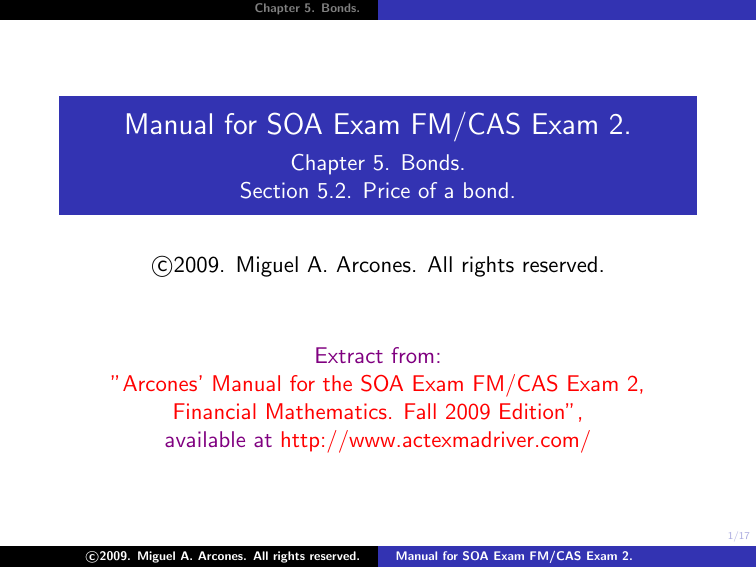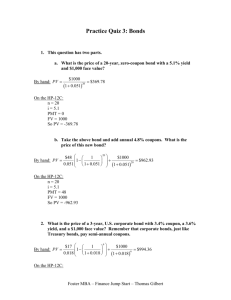
Chapter 5. Bonds.
Manual for SOA Exam FM/CAS Exam 2.
Chapter 5. Bonds.
Section 5.2. Price of a bond.
c
2009.
Miguel A. Arcones. All rights reserved.
Extract from:
”Arcones’ Manual for the SOA Exam FM/CAS Exam 2,
Financial Mathematics. Fall 2009 Edition”,
available at http://www.actexmadriver.com/
1/17
c
2009.
Miguel A. Arcones. All rights reserved.
Manual for SOA Exam FM/CAS Exam 2.
Chapter 5. Bonds.
Section 5.2. Price of a bond.
Bonds
There are two kind of bonds: accumulation bonds and bonds
with coupons. The time at which the loan is repaid is called the
maturity date (or redemption date).
I
In the case of accumulation bonds, the borrower agrees to pay
the loan plus interest at a unique date, called the redemption
time. An accumulation bond is also called a zero coupon
bond.
I
The most common bonds are bonds with coupons. For bonds
with coupons, the borrower agrees to make period payments
(coupons) plus a balloon payment (the redemption value)
C at the maturity date.
2/17
c
2009.
Miguel A. Arcones. All rights reserved.
Manual for SOA Exam FM/CAS Exam 2.
Chapter 5. Bonds.
Section 5.2. Price of a bond.
Cashflow of a bond with coupons.
Every bond has a face value (or par value) F . The coupon
payment is Fr . Here, r is the coupon rate per interest period.
Often, the payments are semiannually and 2r is the annual nominal
rate of interest convertibly semiannually. A bond is called
redeemable at par if C = F . Unless said otherwise we assume
that a bond is redeemable at par. Let n be the number of interest
periods until the redemption date. Let i be the yield rate per
interest period. The cashflow for the borrower is
Contributions
Time
P
0
−Fr
1
−Fr
2
−Fr
3
···
···
−Fr − C
n
3/17
c
2009.
Miguel A. Arcones. All rights reserved.
Manual for SOA Exam FM/CAS Exam 2.
Chapter 5. Bonds.
Section 5.2. Price of a bond.
Variables for a bond.
I
I
I
I
I
I
I
I
I
I
I
I
I
I
P = the price of a bond.
F = the par or face value of a bond.
C = the redemption value of a bond.
r = the coupon rate of a bond.
Fr = the amount of a coupon.
i = the yield rate of the bond per coupon period.
1
ν = 1+i
= the discount factor per coupon period.
n = the number of coupon payment periods.
g = Fr
C = the modified coupon rate of a bond
G = Fri = the base amount of a bond.
K = C ν n = the present value, compounded at the yield rate,
of the redemption value of a bond
P − C = the premium (if P > C ).
C − P = the discount (if C > P).
k = P−C
premium as a fraction of redemption value.
C
c
2009.
Miguel A. Arcones. All rights reserved.
Manual for SOA Exam FM/CAS Exam 2.
4/17
Chapter 5. Bonds.
Section 5.2. Price of a bond.
Price of a bond
The basic formula for the price of a bond is
P = Fra−n−|i + C (1 + i)−n = Fra−n−|i + K .
The premium/discount formula for the price of a bond is
P = Fra−n−|i + C ν n = Fra−n−|i + C (1 − ia−n−|i )
=C + (Fr − Ci)a−n−|i = C + C (g − i)a−n−|i .
The base amount formula for the price of a bond is
P = Fra−n−|i +C ν n = Gia−n−|i +C ν n = G (1−ν n )+C ν n = G +(C −G )ν n .
The Makehan formula for the price of a bond is
1 − νn
P = Fra−n−|i + C ν n = Cg
+ C νn
i
g
g
= (C − C ν n ) + C ν n = (C − K ) + K .
i
i
5/17
c
2009.
Miguel A. Arcones. All rights reserved.
Manual for SOA Exam FM/CAS Exam 2.
Chapter 5. Bonds.
Section 5.2. Price of a bond.
Example 1
Find the price of a 10–year bond, redeemable at par, with face
value of $10,000 and coupon rate of 10%, convertible quarterly,
that will yield 8%, convertible quarterly.
6/17
c
2009.
Miguel A. Arcones. All rights reserved.
Manual for SOA Exam FM/CAS Exam 2.
Chapter 5. Bonds.
Section 5.2. Price of a bond.
Example 1
Find the price of a 10–year bond, redeemable at par, with face
value of $10,000 and coupon rate of 10%, convertible quarterly,
that will yield 8%, convertible quarterly.
Solution: We know that F = C = 10000, n = (10)(4) = 40,
r = 0.10
4 = 0.025, Fr = (10000)(0.025) = 250. and
0.08
i = 4 = 0.02. So, the price of the bond is
P = Fra−n−|i + C (1 + i)−n = 250a40
+ 10000(1.02)−40
−−
|0.02
=11367.77396.
In the calculator, do:
40 N 2 I/Y 250 PMT 10000 PMT CPT PV .
7/17
c
2009.
Miguel A. Arcones. All rights reserved.
Manual for SOA Exam FM/CAS Exam 2.
Chapter 5. Bonds.
Section 5.2. Price of a bond.
Example 2
A 30 year bond matures at its face value of 10,000. It pays
semiannual coupons of 600. Calculate the price of the bond if the
annual nominal interest rate convertible semiannually is 7.5%.
8/17
c
2009.
Miguel A. Arcones. All rights reserved.
Manual for SOA Exam FM/CAS Exam 2.
Chapter 5. Bonds.
Section 5.2. Price of a bond.
Example 2
A 30 year bond matures at its face value of 10,000. It pays
semiannual coupons of 600. Calculate the price of the bond if the
annual nominal interest rate convertible semiannually is 7.5%.
Solution: We know that F = C = 10000, n = (30)(2) = 60,
Fr = 600, and i = 7.5%
2 = 3.75%. The price of the bond is
(600)a60
+ (10000)(1 + 0.0375)−60 = 15341.03109.
−−
|0.0375
9/17
c
2009.
Miguel A. Arcones. All rights reserved.
Manual for SOA Exam FM/CAS Exam 2.
Chapter 5. Bonds.
Section 5.2. Price of a bond.
Remember that unless said otherwise a bond is redeemable at par.
Example 3
What is the price of a 5–year 100 par–value bond having quarterly
coupons at a quarter rate of 1.5% that is bought to yield a
nominal annual rate of 12% convertible monthly?
10/17
c
2009.
Miguel A. Arcones. All rights reserved.
Manual for SOA Exam FM/CAS Exam 2.
Chapter 5. Bonds.
Section 5.2. Price of a bond.
Remember that unless said otherwise a bond is redeemable at par.
Example 3
What is the price of a 5–year 100 par–value bond having quarterly
coupons at a quarter rate of 1.5% that is bought to yield a
nominal annual rate of 12% convertible monthly?
Solution: Solution: We know that F = C = 100,
n = (5)(4) = 20, r = 0.015 and Fr = (100)(0.015) = 1.5. Let j be
the effective yield rate per quarter. We have that i (12) = 12%,
i = 12.68250301% and i (4) = 12.1204%, j = i (4) /4 = 3.0301%.
Hence,
P = 1.5a20
+ 100(1.030301)−20 = 77.29919664.
−−
|3.0301%
11/17
c
2009.
Miguel A. Arcones. All rights reserved.
Manual for SOA Exam FM/CAS Exam 2.
Chapter 5. Bonds.
Section 5.2. Price of a bond.
Example 4
The price of a zero coupon 1000 face value bond is 599.4584. The
yield rate convertible semi–annually is 6.5%. Calculate the
maturity date.
12/17
c
2009.
Miguel A. Arcones. All rights reserved.
Manual for SOA Exam FM/CAS Exam 2.
Chapter 5. Bonds.
Section 5.2. Price of a bond.
Example 4
The price of a zero coupon 1000 face value bond is 599.4584. The
yield rate convertible semi–annually is 6.5%. Calculate the
maturity date.
Solution: Let n be the maturity date in years. We have that
2n
599.4584 = (1000) 1 + 0.065
and n = 8 years.
2
13/17
c
2009.
Miguel A. Arcones. All rights reserved.
Manual for SOA Exam FM/CAS Exam 2.
Chapter 5. Bonds.
Section 5.2. Price of a bond.
Example 5
What is the yield as an annual effective rate of interest on a 100
par–value 10–year bond with coupon rate 6%, convertible monthly,
that is selling for 90?
14/17
c
2009.
Miguel A. Arcones. All rights reserved.
Manual for SOA Exam FM/CAS Exam 2.
Chapter 5. Bonds.
Section 5.2. Price of a bond.
Example 5
What is the yield as an annual effective rate of interest on a 100
par–value 10–year bond with coupon rate 6%, convertible monthly,
that is selling for 90?
Solution: We know that P = 90, C = F = 100,
n = (10)(12) = 120, r = 0.06
12 = 0.005 and
Fr = (100)(0.005) = 0.5. Let j = i (12) /12. Then,
−120 .
90 = P = Fra−n−|j + C (1 + j)−12n = (0.5)a120
−− + 100(1 + j)
|j
Hence, j = 0.618181404%, i (12) = 12j = 7.419376846% and
i = 7.676949087%.
15/17
c
2009.
Miguel A. Arcones. All rights reserved.
Manual for SOA Exam FM/CAS Exam 2.
Chapter 5. Bonds.
Section 5.2. Price of a bond.
Example 6
A 1000 par value 10–year bond with semiannual coupons and
redeemable at 1200 is purchased to yield 8% convertible
semiannually. The first coupon is 50. Each subsequent coupon is
3% greater than the preceding coupon. Find the price of the bond.
16/17
c
2009.
Miguel A. Arcones. All rights reserved.
Manual for SOA Exam FM/CAS Exam 2.
Chapter 5. Bonds.
Section 5.2. Price of a bond.
Example 6
A 1000 par value 10–year bond with semiannual coupons and
redeemable at 1200 is purchased to yield 8% convertible
semiannually. The first coupon is 50. Each subsequent coupon is
3% greater than the preceding coupon. Find the price of the bond.
Solution: The cashflow of coupons is
Coupons
Time (in half–years)
50
1
(50)(1.03)
2
···
···
(50)(1.03)19
20
The present value of the payments is
1
a −− 0.04−0.03 + (1200)(1.04)−20
1.03 20 | 1.03
=878.5721 + 547.6643 = 1426.2364.
(50)
17/17
c
2009.
Miguel A. Arcones. All rights reserved.
Manual for SOA Exam FM/CAS Exam 2.









